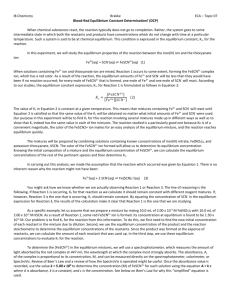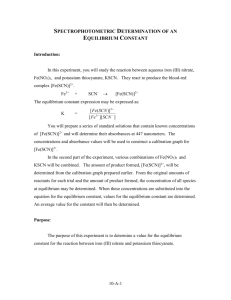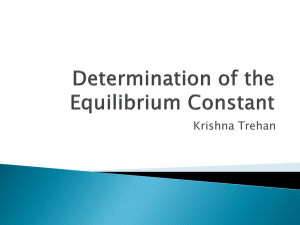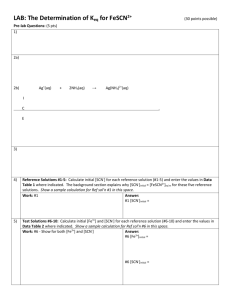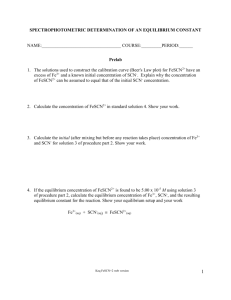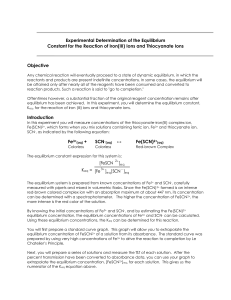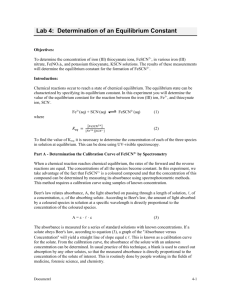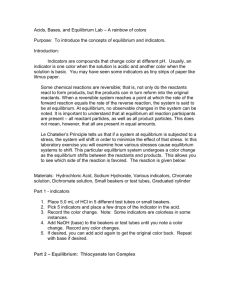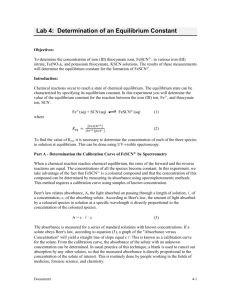Density Determination
advertisement
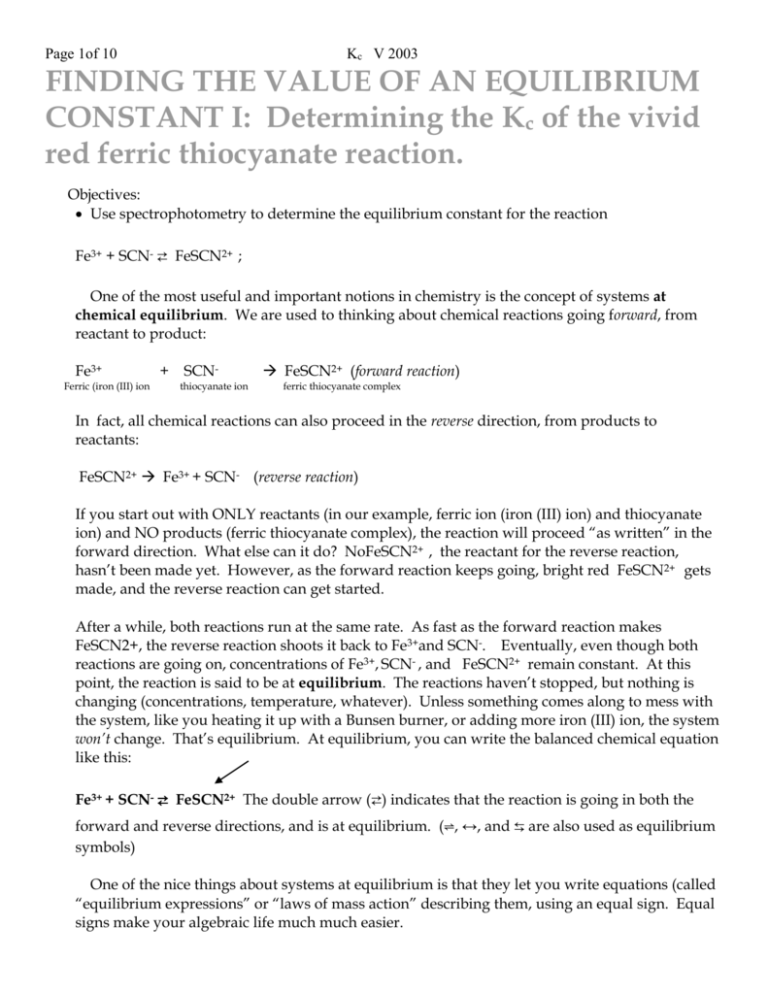
Page 1of 10 Kc V 2003 FINDING THE VALUE OF AN EQUILIBRIUM CONSTANT I: Determining the Kc of the vivid red ferric thiocyanate reaction. Objectives: Use spectrophotometry to determine the equilibrium constant for the reaction Fe3+ + SCN- ⇄ FeSCN2+ ; One of the most useful and important notions in chemistry is the concept of systems at chemical equilibrium. We are used to thinking about chemical reactions going forward, from reactant to product: Fe3+ Ferric (iron (III) ion + SCNthiocyanate ion FeSCN2+ (forward reaction) ferric thiocyanate complex In fact, all chemical reactions can also proceed in the reverse direction, from products to reactants: FeSCN2+ Fe3+ + SCN- (reverse reaction) If you start out with ONLY reactants (in our example, ferric ion (iron (III) ion) and thiocyanate ion) and NO products (ferric thiocyanate complex), the reaction will proceed “as written” in the forward direction. What else can it do? NoFeSCN2+ , the reactant for the reverse reaction, hasn’t been made yet. However, as the forward reaction keeps going, bright red FeSCN2+ gets made, and the reverse reaction can get started. After a while, both reactions run at the same rate. As fast as the forward reaction makes FeSCN2+, the reverse reaction shoots it back to Fe3+and SCN-. Eventually, even though both reactions are going on, concentrations of Fe3+, SCN- , and FeSCN2+ remain constant. At this point, the reaction is said to be at equilibrium. The reactions haven’t stopped, but nothing is changing (concentrations, temperature, whatever). Unless something comes along to mess with the system, like you heating it up with a Bunsen burner, or adding more iron (III) ion, the system won’t change. That’s equilibrium. At equilibrium, you can write the balanced chemical equation like this: Fe3+ + SCN- ⇄ FeSCN2+ The double arrow (⇄) indicates that the reaction is going in both the forward and reverse directions, and is at equilibrium. (⇌, ↔, and ⇆ are also used as equilibrium symbols) One of the nice things about systems at equilibrium is that they let you write equations (called “equilibrium expressions” or “laws of mass action” describing them, using an equal sign. Equal signs make your algebraic life much much easier. Page 2of 10 Kc V 2003 For any common or garden variety reaction: aA + bB ⇄ cC + dD you can write an equilibrium expression (Law of Mass Action): K = [C]c [D]d [A]a [B]b where K is the equilibrium constant. [A], [B], are the concentrations of reactants at equilibrium. [C] and [D] are concentrations of products at equilibrium. a, b, c and d are just the stoichiometric coefficients. The equilibrium expression describing the reaction is: A Bestiary of Equilibrium Constants Equilibrium constants are just what they say they are, a numerical constant which is equal to the concentration of products divided by the concentration of reactants of a reaction at equilibrium. That said, they are given a variety of different subscripts to tell the reader what kind of reaction they are describing. A partial list of equilibrium constants: Kc = [FeSCN2+] [Fe3+][SCN-] . The subscript “c” indicates that the K is an equilibrium constant. Tables of Kc’s can be found in the Handbook of Chemistry and Physics. Ka given to K’s for reactions of acids with water: What do equilibrium constants tell you? Consider: (note: water is not HA + H2O ⇄ A-+ H3O+ Ka = [A-][ H3O+ ]/[HA] Kb given to K’s for reactions of bases with water: CH4 (g) + 2O2 (g) ⇄ CO2(g) + 2H2O (l) expression. The A-+ H2O ⇄ HA + OH- Kb = [HA][ OH- ]/[A-] Kw given to reaction of water with water: H2O + H2O ⇄ H3O+ + OH- Kw = [H3O+][OH-] Ksp given to K’s for reactions of slightly soluble salts with water: MA + H2O ⇄ + Ksp = Keq and Kc given to K’s for reactions that aren’t any of the above. M+ A- [M+][A-] included in the equilibrium Kc = [CO2] [CH4][O2]2 = 2 x 10143 concentration of pure water remains constant and is incorporated into Kc.) Kc is HUGE. This means that if you ignite methane (CH4) in oxygen, when the system comes to equilibrium mostly you will have CO2 and water, and not much methane left. Maybe 1 molecule, if you’re lucky. Which is in fact what happens, based on our experience. On the other hand, consider ammonia breaking down to nitrogen gas and hydrogen gas: 2NH3(g) ⇄ 3H2(g) + N2(g) Kc = [H2]3[N2] = 1.6 x 10-6 [NH3]2 Kc is pretty small. This means that if you wait for ammonia to come to equilibrium with hydrogen gas and nitrogen gas, you’ll still have mostly ammonia, and only a very little H2 and N2. Page 3of 10 Kc V 2003 The magnitude (size) of Kc tells you how far the reaction will proceed as written before equilibrium sets in. It doesn’t tell you how fast it will get to equilibrium, just what the ratio of reactants to products will be when the system gets to equilibrium. Which brings us to this week’s lab. Your goal: Find the Kc for the reaction Fe3+ + SCN- ⇄ FeSCN2+ . You will do this by mixing known volumes of known solutions of iron(III) nitrate and sodium thiocyanate together, letting them come to equilibrium, and then measuring the concentration of FeSCN2+ made spectrophotometrically. You will first need to construct a standard curve of known [FeSCN2+ ] vs. absorbance at 442 nm. To make 5 L of 0.25 M HNO3: THE EXPERIMENT: Conc HNO3 = 16 M Add 80 mL of conc HNO3 to 5 L of DI water in a carboy. Stir well. You will need: 0.002 M NaSCN in 0.25 M HNO3 0.25 M HNO3 50 mL 500 mL 125 mL 25 mL 0.25 M Fe(NO3)3 in 0.25 M HNO3 0.002 M Fe(NO3)3 in 0.25 M HNO3 To make 2 L of 0.002 M NaSCN in 0.25 M HNO3: MW NaSCN = 81.08 g/mol. Note: KSCN can be substituted. Weigh 0.16 g NaSCN on the analytical balance. RECORD THE MASS to the nearest 0.1 mg! Dissolve it in 0.25 M HNO3 in a 2.00 L volumetric flask, and dilute to the mark. Mix thoroughly. Record the calculated concentration to 4 significant figures. RECORD THAT CONCENTRATION ON THE BOTTLE! To make 2 L of 0.25 M Fe(NO3)3 in 0.25 M HNO3: 100.00 mL volumetric flasks 10.00 mL volumetric flasks Pastuer pipets and bulbs Pipet set: 1 mL, 2 mL, 3 mL, 4 mL, 5 mL, 10 mL, 15 mL, 25 mL volumetric pipets, with blue bulb 100 mL beakers UV-Vis spectrophotometer, cuvettes, kimwipes, waste beaker 5 5 1 set MW Fe = 55.85 g/mol Weigh 28 g of Fe filings and place in a 2 L flask. Dissolve them in 32 mL of conc HNO3. Carefully dilute to 2 L with DI water. Stir. To make 2 L of 0.002 M Fe(NO3)3 in 0.25 M HNO3: 2 Weigh 0.22 g of Fe filings on the analytical balance. RECORD THE MASS TO THE NEAREST 0.1 mg! Place the filings in a 2.00 L volumetric flask, and dissolve them in 32 mL of conc. HNO3. Carefully dilute to the mark with DI water, stir. CALCULATE AND RECORD ON THE FLASK the [Fe(NO3)3 to 4 significant figures! Make a blank (25 mL of 0.25 M Fe(NO3)3 in 100 mL of 0.25 M HNO3) for the spectrophotometer. Page 4of 10 Kc V 2003 Caution: HNO3 is caustic and corrosive. Protect your eyes with safety glasses. NEVER pipet by mouth!. THE PROCEDURE: Before you come to lab: Make an Excel Template of the data charts n page 7-8. PUT IT ON A FLOPPY DISK & BRING IT TO LAB. BRING YOUR KNIGHTCARD TO LAB!!!! 1. WRITE DOWN the [Fe(NO3)3] concentrations listed on the stock bottles, in your notebook. NOT THERE AT THE END OF LAB? 25 POINTS OFF. 2. NOTICE that there are 2 (two), more than one, Fe(NO3)3 solutions. Notice which one is which. Look in your lab protocol outline and UNDERLINE at what steps you use which solution. This is IMPORTANT!!! 3. WRITE DOWN the [NaSCN] concentration listed on the stock bottle, in your notebook. NOT THERE AT THE END OF LAB? 25 POINTS OFF. 4. NOTICE that there is a carboy of 0.25 M HNO3 at the end of bench 2. This does not contain NaSCN or Fe(NO3)3. Look in your lab protocol outline and UNDERLINE at what steps you use this solution. This is IMPORTANT!!! Now you can start labeling glassware and getting organized. You will use the 1.00, 2.00, 5.00, and 10.00 mL pipets first, together with the 100.00 mL volumetric flasks. Label the flasks S1,S2…S5. STANDARDS: In this part of the lab, you will make up standard solutions that contain known [FeSCN2+]. The reaction is: Fe3+ + SCN- ⇄ FeSCN2+ Kc = [FeSCN2+ ]/ [Fe3+][SCN-] > 1 We want the reaction to go virtually 100% to completion, so that we know the [FeSCN2+] and can use that to make our standard curve. As it happens the Kc for this reaction is greater than one. At equilibrium, much of the Fe3+ and SCN- have reacted to make FeSCN2+. Le Chatelier’s Principle, and simple algebra, tell us that we can maximize the amount of product made . The equilibrium will move right if the concentration of Fe3+ or SCN- is high. Let’s give this some thought. If you make [Fe3+] high at equilibrium, then the [FeSCN2+] at equilibrium must be high, and [SCN-] really low so that the equilibrium conditions are met. Suppose Kc = 10 (it doesn’t, but suppose) Start with 0.01 M Fe3+ , 0.01 M SCN-, and 0 M FeSCN2+. At equilibrium, the [Fe3+] is 0.0092 M, [SCN-] is 0.0092 M and [FeSCN2+] is 0.00084 M. (See appendix 1 for help on how to figure this out). Plug these Page 5of 10 Kc V 2003 values into the equilibrium expression to convince yourself that the ratio of reactants to products comes out equal to Kc Now, see what happens when you swamp the system with one reactant. Start with 1 M Fe3+ , 0.01 M SCN-, and 0 M FeSCN2+. At equilibrium, the [Fe3+] is 0.991 M, [SCN-] is 0.00091 M and [FeSCN2+] is 0.0091 M. Plug these values into the equilibrium expression to convince yourself that the ratio of reactants to products comes out equal to Kc. Swamp the system with Fe3+ and almost all the SCN- gets converted into FeSCN2+ If you know how much SCN- you started with, you can get a pretty good (not perfect, but pretty good) estimate of the [FeSCN2+] you make at equilibrium. All that being said, now you are ready to make up standard solutions, in which the [FeSCN2+] made is approximately equal to the [NaSCN] you start with. 5. Make up the 5 standard solutions, following the chart, and NOTING AND RECORDING YOUR OBSERVATIONS. Notice the concentrations of reagents you are to use. Write down the actual concentrations as listed on the stock bottles in your notebook! The TA will make up solution 0. Use a set of labeled 100.00 mL volumetric flasks for this series. Be sure you pipet and dilute correctly! Keep pipets vertical at all times; Never pipet by mouth; Bring the liquid level up in the pipet past the scratch on the neck. Drain it until the bottom of the meniscus sits on the scratch; Drain the pipet into the labeled volumetric flask. Just touch the tip of the pipet to the side of the flask. Keep that pipet vertical! Carefully add 0.25 M HNO3 to the 100.00 mL volumetric flasks until the bottom of the meniscus sits on the scratch; Cap or parafilm the volumetrics and mix the solutions thoroughly! 30 inversions is the canonical number. NOTE AND RECORD YOUR OBSERVATIONS! 6. Find a UV-visible spectrophotometer and measure absorbance of your standard solutions.. Remember when using the cuvettes to touch only the frosted sides, not the clear sides. Find the Page 6of 10 Kc V 2003 absorbance of light by all 5 of your standard solutions and the 0 solution at 448 nm. FeSCN2+ are redorange, and will thus absorb blue-green light (the 448 nm light). Beer’s Law describes the relationship between light absorption and concentration: Beer’s Law is given by the equation A = εbc, where A = absorbance of light, b = the path length of light through the sample, c = concentration of lightabsorbing compound in the sample and ε is a constant of proportionality called the extinction coefficient. As you can see, absorption of light is directly proportional to concentration. Record your absorbance data in your notebook!. Once you are finished with the spectrophotometer, you can discard the standard solutions in the waste jug in the hood, rinse your glassware and 7. Graph your standard curve. Graph your data, with absorbance at 448 nm on the Y-axis and [FeSCN2+] on the x-axis. (See below for sample calculations) MOVE ON TO MAKE UP THE “EXPERIMENTAL” SOLUTIONS. The next set of solutions you make up, the “experimental” solutions, will NOT have one reactant added in vast excess to push the equilibrium far to the right. You will make up solutions in which approximately equal amounts of each reactant are mixed. You will then use your standard curve data to determine the [FeSCN2+] made, and how much Fe3+ and SCN- are left over at equilibrium. Then you can calculate Kc. EXPERIMENTAL 8. Make up the 5 “Experimental” solutions, following the chart, and NOTING AND RECORDING YOUR OBSERVATIONS. Notice the concentrations of reagents you are to use. They are NOT the same as last time! Write down the actual concentrations as listed on the stock bottles in your notebook! Use a labeled set of 10.00 mL volumetric flasks for this series. Be sure you pipet and dilute correctly! Keep pipets vertical at all times; Never pipet by mouth; Bring the liquid level up in the pipet past the scratch on the neck. Drain it until the bottom of the meniscus sits on the scratch; Drain the pipet into the labeled volumetric flask. Just touch the tip of the pipet to the side of the flask. Keep that pipet vertical! Carefully add 0.25 M HNO3 to the 10.00 mL volumetric flasks until the bottom of the meniscus sits on the scratch; Cap or parafilm the volumetrics and mix the solutions thoroughly! 30 inversions is the canonical number. Page 7of 10 Kc V 2003 NOTE AND RECORD YOUR OBSERVATIONS! 9. Find a UV-visible spectrophotometer and measure absorbance of your “experimental” solutions.. Remember when using the cuvettes to touch only the frosted sides, not the clear sides. Find the absorbance of light by all 5 of your solutions at 448 nm. Record your absorbance data in your notebook!. Keep in mind that absorbance is proportional to the amount of light absorbed, A = εbc, and εb is the slope of your standard curve. Once you are finished with the spectrophotometer, you can discard the standard solutions in the waste jug in the hood, rinse your glassware and calculate the Kc for the reaction: Fe3+ + SCN- ⇄ FeSCN2+ Kc = [FeSCN2+ ]/ [Fe3+][SCN-]. CLEAN UP! Wash all glassware with DI water and return them. Wash all pipets with DI water and leave them to drain. Wash cuvet with DI water and leave it at the instrument. ALL WASTE FROM THIS EXPERIMENT GOES IN THE JUG LABELLED “Ferric Thiocyanate Waste” IN THE HOOD. CALCULATIONS: 1. SAMPLE CALCULATIONS FOR STANDARD SOLUTIONS: Data: Note that the concentrations of stock reagents in this example are NOT what you used in your experiment. Use your own!. 2. mmoles NaSCN: moles/L is the same as mmoles/mL. Convert moles/L to mmoles/mL and convince yourself!. 1.00 mL NaSCN(1.000 x 10-3 mmoles NaSCN/mL) = 1.000 x 10-3 mmoles NaSCN = 1.000 x 10-3 mmoles SCN- ; 4. [SCN-]: 1.000 x 10-3 mmoles SCN- lives in a total volume of 100.00 mL of solution: 1.000 x 10-3 mmoles SCN-/ 100.00 mL = 1.000 x 10-5 mmole SCN-/mL = 1.000 x 10-5 mole SCN-/L = 1.000 x 10-5 M SCN5. [FeSCN2+]: Since we have swamped the system with Fe3+ and driven the equilibrium far to the right, the [FeSCN2+] ≈ [SCN-] Page 8of 10 Kc V 2003 USE THIS DATA FOR YOUR STANDARD CURVE: SAMPLE CALCULATIONS FOR “EXPERIMENTAL” DATE TO DETERMINE Kc Data: Note that the concentrations of stock reagents in this example are NOT what you used in your experiment. Use your own!. 2. mmoles Fe3+initial: moles/L is the same as mmoles/mL. Convert moles/L to mmoles/mL and convince yourself!. 5.00 mL Fe(NO3)3(5.000 x 10-3 mmoles Fe(NO3)3/mL = 2.500 x 10-2 mmoles Fe(NO3)3 = 2.500 x 10-2 mmoles Fe3+ ; 4. mmoles SCN-initial: moles/L is the same as mmoles/mL. 1.00 mL NaSCN)(1.000 x 10-3 mmoles NaSCN/mL) = 1.000 x 10-3 mmoles NaSCN = 1.000 x 10-3 mmoles SCN- Page 9of 10 Kc V 2003 2+ 7. [FeSCN ]: In this set of experiments, we have NOT swamped the system with Fe3+. We must calculate the [FeSCN2+] from the standard curve: The equation of the best fit straight line is in the form y = mx + b, where y is the absorbance of any sample of FeSCN2+, x is the [FeSCN2+], m is the slope and b is the y-intercept. 0.4701 = 4867.4[FeSCN2+] + 0.008958 [FeSCN2+] = (0.4701 - 0.008958)/ 4867.4 = 9.47 x 10-5 M 8. mmoles FeSCN2+: 10.00 mL solution (9.47 x 10-5 mmoles FeSCN2+/mL) = 9.47 x 10-4 mmoles FeSCN2+ = mmoles Fe3+ used = mmoles SCN- used 9. mmoles Fe3+ unreacted: mmoles start –mmoles eq = 2.500 x 10-2 mmole - 9.47 x 10-4 mmole = 2.41 x 10-2 mmoles Fe3+ unreacted & present at equilibrium. 10. [Fe3+] at equilibrium: 2.41 x 10-2 mmoles Fe3+/10.00 mL = 2.41 x 10-3 M Fe3+ 11. mmoles SCN- unreacted: mmoles start –mmoles eq = 1.000 x 10-3 mmole - 9.47 x 10-4 mmole = 5.26 x 10-5 mmoles SCN- unreacted & present at equilibrium. 12. [SCN3+] at equilibrium: 5.26 x 10-5 mmoles SCN- /10.00 mL = 5.26 x 10-6 M SCN13. Kc : [FESCN2+]eq/[Fe3+]eq[SCN-]eq = (9.47 x 10-5 M FeSCN2+)/(2.41 x 10-3 M Fe3+)(5.26 x 10-6 M SCN-) = 7490 LAB WRITE UP: You should have all your data and all your results for your standard curve in Excel. You should have a graph of your standard curve, with best fit straight line, equation for best fit straight line and correlation coefficient. You should have all your data and all your results for your “experimental” section in Excel. You should show sample calculations. You should have detailed observations. Include a summary of your data and an analysis of your results. Page 10of 10 Kc V 2003 APPENDIX 1: EQUILIBRIUM CALCULATIONS: To determine the concentration of reactants and products at equilibrium, given starting concentrations: Using our example: Start: Equilibrium: Fe3+ 0.01 M 0.01 M – x + SCN⇄ FeSCN2+ 0.01 M 0 0.01 M – x x Kc = [FeSCN2+ ]/ [Fe3+][SCN-] = 10 I don’t know how much will react, but I know some will! Call that “x”. Plugging equilibrium values into the equilibrium expression, I get: x/(0.01-x)(0.01-x) = 10 0.001 –1.2x + 10x2 = 0 . Now I use a quadratic equation solver (I’m lazy) such as the one at http://www.edteach.com/algebra/quad_explorer/quadratic.html x1 = x2 = 0.11916079783099616 0.0008392021690038387 Notice that they ignore significant figures. You’ll have to fix that yourself. Root 1 makes no sense; I’d be making more stuff than I started with. Root 2 works. x is the [FeSCN2+] at equilibrium.
